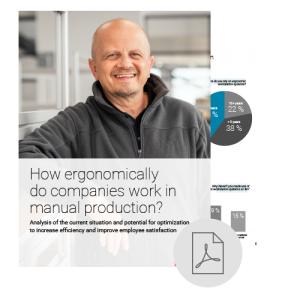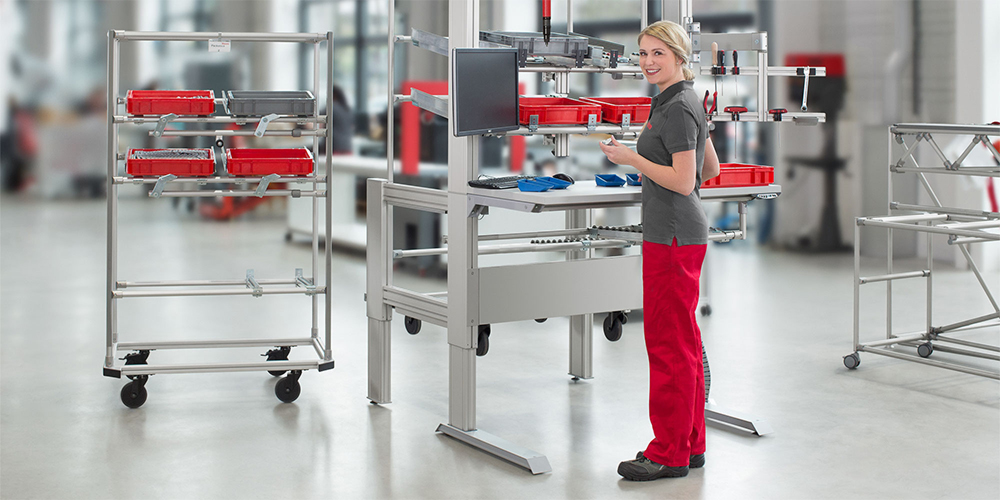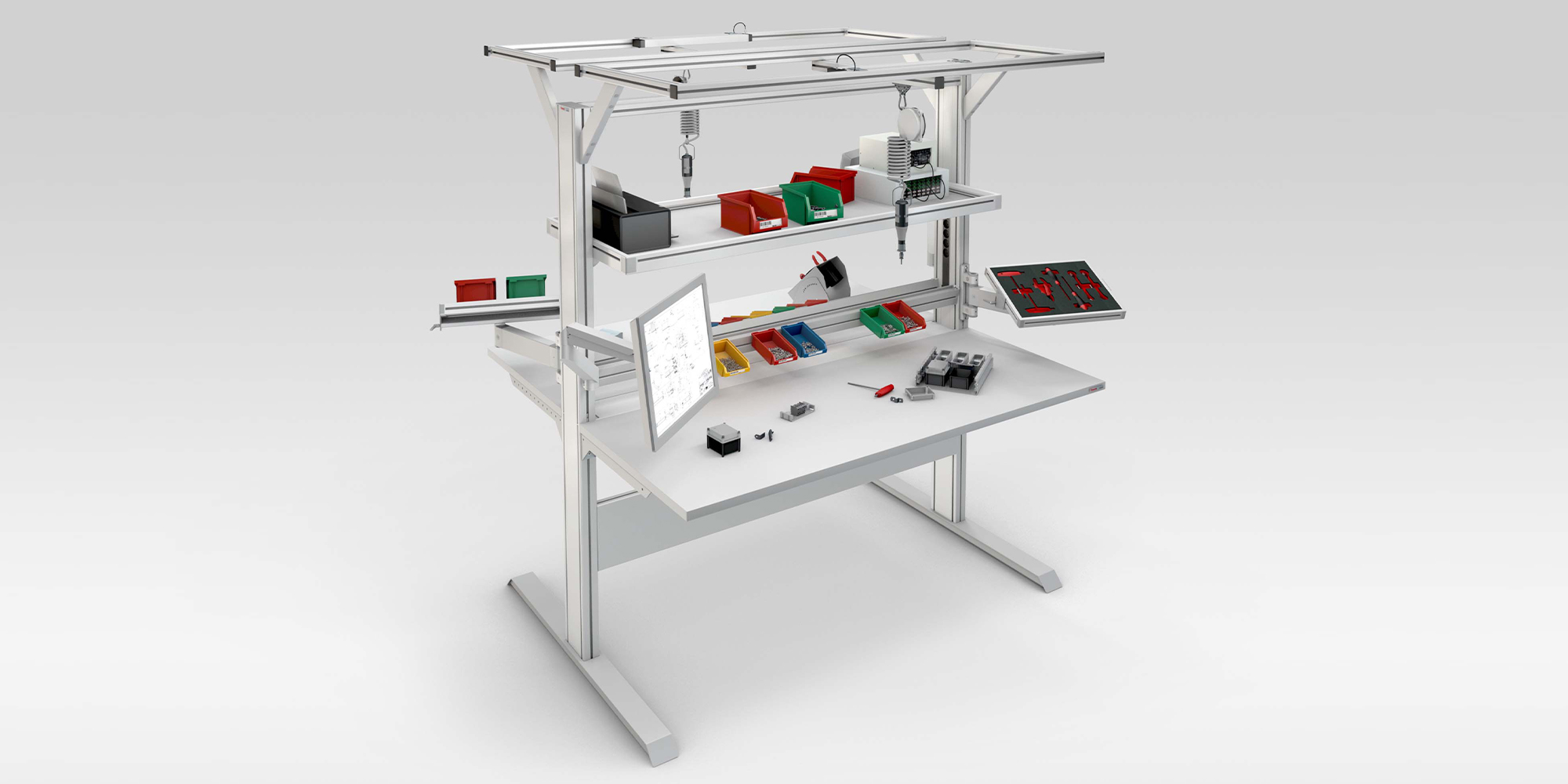Creating ideal conditions to boost productivity and prevent work-related illnesses involves everything from height-adjustable work benches to the right light colour.
In manual production, the design of a work bench plays a big part in ensuring products can be manufactured or assembled efficiently and to a high quality standard. The role of ergonomics is vital, but what exactly does “ergonomic” mean in the industrial context and what do ergonomic measures achieve? Marius Geibel, an item expert on ergonomic work bench systems, describes the benefits of ergonomics as follows: “Ergonomics is often seen as an unnecessary and costly way of trying to turn the workplace into some kind of health spa. In a holistic approach, however, improving productivity is an integral aspect of ergonomics. In practical terms, ergonomics and efficiency go hand in hand. Staff who are not under unnecessary strain are more motivated and perform better. Ergonomics helps companies to retain their workforce for the long term.” In the following overview of work bench design in production, we explain the basics of ergonomics and provide some practical tips.

New ergonomics study
This study shows which ergonomic measures are already being used in manual production. Find out more and see how you compare – how far ahead is your company?
GET YOUR COPY NOW
Solutions for work bench design in production
It’s advisable to use height-adjustable work benches for manual production work. Being able to switch between sitting and standing at the work bench helps to alleviate physical strain, which is vitally important. Sitting in the same position for hours on end brings with it the risk of tension that can cause chronic pain, so height-adjustable, ergonomic industrial work benches are a key factor when it comes to keeping staff healthy and productive. Workers should be able to switch position quickly, which makes electrical height adjustment a definite advantage.
With electrically height-adjustable work benches, it’s possible to store various height settings and access these directly – when changing shifts, for instance.
A high-quality, ergonomic work bench system like the one provided by item therefore has powerful electric motors that can change the height setting very quickly. It’s also possible to store various height settings and access these directly – when changing shifts, for instance. Following a quick basic introduction to the work bench, staff independently select the ideal configuration that they find most comfortable and can make adjustments at any time, if necessary. The type and size of work bench and its load-carrying capacity depend on the process-based requirements. The table top should be selected with a view to ruling out glare from reflections and unpleasant contact temperatures.

Ergonomic work chairs for manual assembly
The quality of a work chair has a major impact on the wellbeing of production staff, whose range of movement should not be restricted. On the contrary, ergonomic work chairs at production work benches need to enable dynamic sitting, that is to say deliberately changing position and posture as often as possible so that one side of the body isn’t overworked and specific muscle groups aren’t put under excessive strain. An ergonomic industrial work chair supports dynamic sitting by synchronising the movement of the seat and backrest. Ideally, the seat should dip forward slightly and rotate. A backrest with height adjustment and a tilt mechanism incorporating tension control makes it possible to maintain an ideal working posture at all times. Besides design and technology aspects (environmental ergonomics), however, the way staff act (behavioural ergonomics) is also important. One example of behavioural ergonomics is an item illustration showing how to sit correctly on a chair.
An ergonomic chair for manual production places less strain on the back, because it can be adjusted to suit each employee perfectly.
Moreover, ergonomic work chairs for industrial use should have braking castors, and high-level chairs should have castors that lock when under load. This simple yet effective technology reduces the risk of occupational accidents without compromising on mobility. Work chairs at assembly work benches should ideally be designed so that staff are able to use all the adjustment options intuitively. An ergonomic chair for optimum work bench design in manual production places less strain on the back, because it can be adjusted to suit each employee perfectly. Another crucial feature of a high-quality industrial chair is durable upholstery that is easy to clean and resistant to lubricants.
Importance of the work bench handling area
Everyone is different. The handling area is a perfect example and demonstrates just why ergonomic work bench design is so vital in production. The handling area is the space where staff can reach every point vertically or horizontally with one or both hands, without having to leave their sitting or standing work bench. Given that people come in all shapes and sizes and have specific requirements, every handling area is unique. A flexible, modular ergonomic work bench system and its wide-ranging components are the perfect solution for this individuality. Generally speaking, the handling area comprises a one-handed zone, an extended one-handed zone and a two-handed zone. This is illustrated below. Materials and tools that are required on a regular basis should be placed in the one-handed zone (orange) so that they can be reached without having to turn. This highlights the benefits of ergonomics.

The use of pivot arms (ideally with three joints) on components for picking, supplying and stowing materials and tools ensures all employees can customise their workspace. Flexibility of this kind is equally effective in ensuring quick access and relieving physical strain. The extended one-handed zone (pale blue) is intended for materials and tools that are required less often. It also includes areas beyond the actual work bench – when utilising height-adjustable material supply trollies, for instance. Value-adding work is carried out directly in front of the employee, in the two-handed zone (green), so this is where products are made. It’s also where the employee’s visual acuity is at its best.
Role of lighting for work bench design in production
The importance of lighting when it comes to ergonomic work bench design in production is still underestimated. This was demonstrated by the item ergonomics study entitled “How ergonomically do companies work in manual production?”, which also investigated the most commonly used ergonomic solutions. While 76 percent of participating companies use ergonomic work chairs and 75 percent ergonomic work benches, the figure for lighting is just 55 percent. In this area too, however, a specific technology solution has proved successful – LED industrial lights. The light colour of LED lights at work benches is particularly important. When it comes to light colour, which is measured in Kelvin (K), the following key distinction is made:
- Cold white light: 3330 to 5300 K – stimulating effect on the biorhythm
- Warm white light: 2700 to 3300 K – relaxing, calming effect
Striking the right balance at manual assembly work benches is vital. A light colour of approximately 4000 K provides gentle light that boosts productivity. This is midway between a light bulb (approx. 2700 K) and normal daylight (above 5300 K). Besides an unsuitable light colour, multiple shadows can also have a negative impact on the eyes. These multiple, superimposed hard shadows created by individual spotlights cause fatigue and make it harder to concentrate. LED industrial light technology combats this with homogeneous illumination that produces only soft shadows. This property and the flicker-free light generated by high-frequency LED industrial lights significantly reduce eye strain. Although staff aren’t consciously aware of something like low-frequency flickering, it causes them to get headaches and feel unwell.

Displaying information in manual production
Ergonomic considerations are also important when it comes to displaying information at the work bench. It should preferably be arranged in order of importance, starting in the centre and moving outwards. To rule out unnecessary tilting of the head, it’s vital to avoid displaying information high up. As a result of growing digitalisation in assembly, industrial work benches also increasingly have monitors. In this case, too, appropriate accessories are available that can be adjusted to specific requirements. Thanks to slewable arms, monitors can be positioned precisely and, most importantly of all, adapted to each individual’s requirements so as to prevent physical strain. Generally speaking, screens should never be located at the side, but rather directly in the employee’s field of vision.
Work bench interlinking and ergonomic material supply & picking
Work benches in manual production should ideally be suitable for a number of different logistics concepts, which means they can switch, for example, from made-to-order to assembly line production. This calls for an industrial work bench system that has all the necessary components and is highly adaptable. Staff should be able to continue using the same work bench equipment that they worked with during made-to-order production. Given that work benches need to be connected together for assembly line production, interlinking systems such as roller conveyors and transport trollies are used in line with the lean production philosophy.
Modular transport trolleys make it possible to achieve the ideal size, shape and configuration for any application.
Transport trolleys are only efficient if they have a modular design that means they can be modified in a few simple steps. This technology makes it possible to achieve the ideal size, shape and configuration for any application. Material supply & picking is another key factor in effective ergonomic work bench design for production operations. Avoiding strenuous movements such as heavy lifting speeds up supply & picking tasks and reduces strain. item calls the direct linking of work bench ergonomics and lean intralogistics “ergologistics”. Special components are available for this. For example, small parts in standard containers can be resupplied to industrial work benches from the rear, simply by sliding them down trays fitted with a raised edge at the operator’s side.

Would you like to keep up-to-date with developments relating to ergonomics? Then we have something that’s right up your street! Simply subscribe to the item blog by completing the box at the top right.


